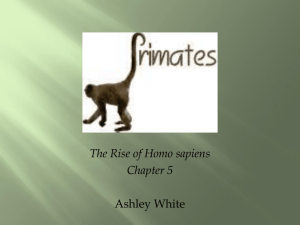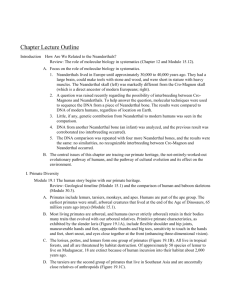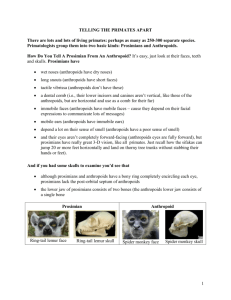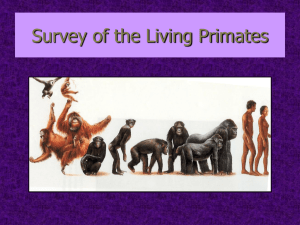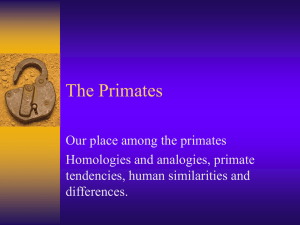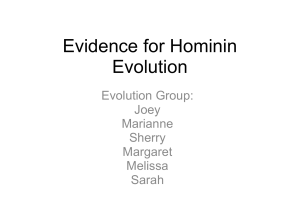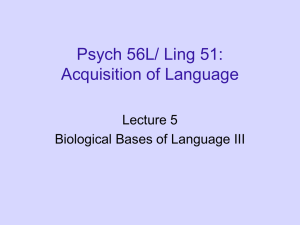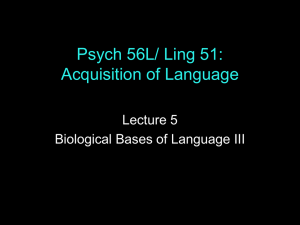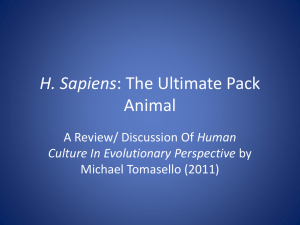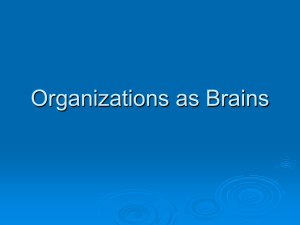Primates
advertisement
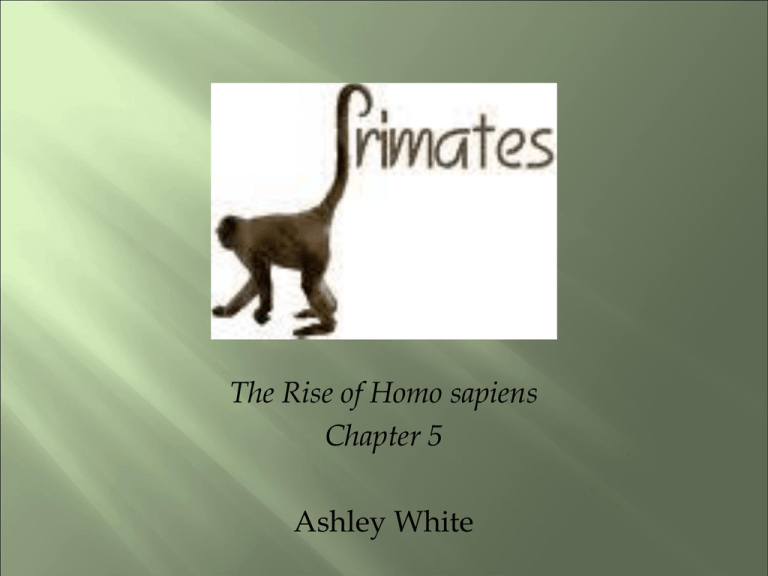
The Rise of Homo sapiens Chapter 5 Ashley White Human brains = Primate brains Much of our brain’s anatomy and the way we think is the way it is because we are primates Primates are the Order within the Class Mammalia Encompasses monkeys, apes (including humans), and prosimians All living primates share a common ancestor Mammal who lived 50 million years ago, during the great expansion and diversification of mammals that followed the extinction of the dinosaurs Most living primates are tropical 2 major exceptions are humans and macaques (Japanese snow monkeys) Most primates are arboreal Spend some or all of their lives in trees This is reflected in primate anatomy, including the anatomy of those who no longer live in trees Grasping hands and feet for locomotion Well-developed visual system Because primates have been around for over 50 million years, they have had ample opportunity to evolve a wide variety of specific anatomies and adaptive niches We will review the developments, old and recent, that are directly relevant to the evolution of human cognition Primate brains are adapted to the demands of an arboreal way of life Expanded ventral premotor cortex, part of the motor cortex controlling hand and finger movement Good at directing fine motor action The most salient developments occurred in the areas of the brain that process visual information The center of a primate’s retina is densely packed with photo-receptors This allows for detailed perception in the center of the visual field Perceptual information passes from the retina though the lateral geniculate nucleus of the thalamus to the primary visual cortex of the occipital lobes Here, the “raw” data is initially processed and passed on to the parietal and temporal lobes, where more complex analysis occurs Primates are particularly good at recognizing shapes and locating themselves in space Stereoscopic Vision: Primate eyes face forward, with considerable overlap in the visual fields of each eye By comparing the two slightly different images, the visual cortex is able to construct depth Advantage: depth is perceived easily when moving about in the tops of tropical trees Disadvantage: primates cannot see to rear Hemifield (half-field) vision: Source of “lateral visual field neglect” in humans Unlike humans, most mammals have the entire visual field of each eye processed contralaterally If brain damage occurs, the ability to process information on one side of the visual field may be lost No one is quite sure why the primate visual system works this way About 40 million years ago, the large group of primates that includes monkeys, apes, and humans diverged from the earlier primates These earlier primates survive today as the prosimians Anthropoids were larger than the prosimians Developed a dietary focus on fruit and leaves, unlike the largely insectivorous prosimians Also had larger brains, and in particular a larger neocortex With the anthropoids, there were new developments to the visual system Trichromatic color vision results in the full range of color perception enjoyed by humans, apes, and monkeys Required a mutation (probably a gene duplication) that added a third variety of cone to the retina, along with neural resources in the primary and secondary cortices It evolved in anthropoid ancestors as an aid to detecting food in complex forest canopies, most likely fruit Over time, anthropoids also developed a much-heightened ability to recognize faces and facial expressions This resulted from an expansion of the inferotemporal visual cortex, the area of the neocortex linked to shape recognition This is sometimes termed the “ventral pathway” of visual processing Information passes from the primary visual cortex of the occipital lobes forward to the temporal lobes, where more sophisticated visual processing takes place The neurons involved in facial recognition are linked to the amygdala, the structure that attaches emotional value to perceptions Anthropoids use facial expression to communicate emotional states, which play an essential role in anthropoid social behavior It is social behavior that explains not just the increase in anthropoid inferior temporal visual cortex, but also the increase in overall brain size and neocortex size Anthropoids have an EQ of about 2.1 Overall brain size is about twice as large as predicted for a placental mammal of comparable size However, there is a great deal of variability Old World monkeys ≈ 1.05 Humans ≈ 6.0 Some of this variation in brain and neocortex size appears related to the total amount of visual information coming in from the eyes This suggests that visual specializations of various kinds may effect overall brain size Some of the variability also appears to result directly from the evolutionary trade-off between brain size and gut length Folivory (leaf-eating) anthropoids have smaller brains and neocortices than frugivory (fruit-eating) anthropoids Leaves must be fermented in a very long gut in order to yield digestible carbohydrates This requires a heavy metabolic investment in digestion The balance cannot be made up by decreasing reliance on hearts, kidneys, or livers (other metabolically expensive tissues) So…brain size must be limited in folivores This explains why folivores have smaller brains, but why do frugivores need larger brains? There are 2 possibilities: Something about foraging for fruit selected for larger brains and neocortices Probably “mental mapping” The ability to locate oneself and others, and navigate in complex forest habitats This spatial mapping ability is a function of the parietal cortex (the dorsal pathway of visual processing) In tropical forests, fruit is distributed in small, concentrated patches that ripen at different times throughout the year Because fruit is a high-quality nutrition, it is under great demand There is serious competition from birds and other mammals Anthropoids have a mental map of territory Move efficiently between patches Remember where patches are and when they are likely to be available “Plan” a foraging pattern that is more effective in the face of competition The switch to the concentrated, easily digestible, high-quality nutrition of fruit released selective pressure against larger brains Freeing them to expand in response to other selective pressures Probably social complexity Anthropoids live in a variety of social systems, from the mostly solitary orangutan males to large multi-male/female troops of baboons One association of complexity is group size, based on assumption that more individuals produce more interactions However, when primatologists tried to correlate brain size with group size, they found no relationship But, group size does reliably predict neocortex size Human neocortex falls about where it should for a group size of about 150 Brain size correlates with several life-history factors Age at first reproduction Length of the juvenile period Several ways to explain this: 1) Both brain size and maturation reflect an increase in body size But, when body size is controlled, the correlation remains 2) Natural selection may have favored delay of reproductive age because of niche complexity and energetic cost of reproduction, and brain growth was a by-product But, most brain growth occurs pre- and neo-natally, so a simple by-product explanation seems weak 3) Selection for brain growth would require lengthening of juvenile periods and age of first reproduction, because there is a greater amount of information to be learned 4) Combination of these and other factors What is clear: brain growth cannot have occurred simply through selection for more neurons in an adult individual The process entailed changes in brain and physical development It was not simple, and it was energetically expensive With the exception of humans, apes today are much less numerous and successful than the monkeys There are only four species of great apes (chimpanzees, bonobos, gorillas, orangutans) , all of which are declining in number They were most varied and successful during the Miocene age (23 million to 5 million years ago) It is the slowness of reproduction that placed apes at a disadvantage, compared to Old World monkeys Apes: long gestation, increased inter-birth interval, long juvenile period Monkeys: reproduce much faster, almost as clever What we know: Long juvenile periods and late age of first reproduction correlate strongly with brain size What we DON’T know: Which came first? Do apes have large brains because they have extended developmental periods, or did their large brains require extended development for learning? Unexpected conclusion: We can suspect that large brains may be partially to blame for the apes’ recent evolutionary decline If large brains no longer yield a competitive edge, their owners will go extinct. Large brains are metabolically expensive Large brains have profound life-history consequences What edge did ape brains initially possess? Expansion of planum temporale (area on the dorsal surface of the superior temporal lobe) Expansion of Brodman’s area 44 (left ventral motor cortex) These areas have been linked to apes’ more complex vocalizations What edge did ape brains initially possess? Lateral cerebellum of apes is 2.5x larger than monkeys This controls many basic postural functions Also involved in cognitive planning of complex motor actions, sequential patterning, and procedural learning Some have suggested that great ape encephalization is linked to suspensory locomotion in forest canopies Others propose that it may be linked to “complex foraging” and access to embedded foods Well-known as tool-users and tool-makers Habitually use tools to access hard-to-acquire foods such as termites, hard-shelled nuts, and honey from well-defended nests Solutions vary between communities, but all rely on complex motor manipulations of objects, sometimes requiring a series of tools Have been observed using tools to break open nests “Extractive foraging” – the use of tools to access hidden and embedded foods Early Hominins Probably inherited from the common ancestor They rarely use tools, but do use organized, complex manipulations to gain access to the pith of nettles Such manipulations require cognitive resources similar to those required for chimpanzee tool use It seems that this pattern of complex feeding is shared by all of the great apes This may explain the very significant difference in the size of the lateral cerebellum, when compared to monkeys The specific adaptations we have discussed do not seem general enough to explain the increase in overall neocortex size of all anthropoids Also doesn’t explain the flexible problem solving abilities we associate with apes This generalizability problem led primatologists to search for features of anthropoid lives that might have selected for a general problem-solving ability Social behavior Nicholas Humphrey (1976) Suggested that the complex social lives of anthropoids selected for their problem-solving abilities Richard Byrne & Andrew Whiten (1988) Pulled together various authors into a volume that summarized evidence for the leading role of social behavior in primate cognition Machiavellian Intelligence Argues that the most complex part of a primate’s daily life is the ever-changing nature of polyadic social interactions Polyadic – more than two individuals Dyadic – how one relates to one other individual Primate social groups often consist of adult females, their offspring, and adult males Success in reproduction and access to highquality foods requires constant monitoring of one’s social standing The most successful individuals monitor not only dyadic relationships, but also polyadic relationships Soap opera = good anthropoid primates What we know: There is a correlation between anthropoid neocortex size and social group size, which probably reflects the increasing complexity of polyadic interactions in larger social groups What we DON’T know: What is so mentally challenging about polyadic interactions? Tactical deception Theory of mind Occurs when one individual misleads a second individual in order to obtain some immediate goal, normally available to or under control of the second Novel response to a specific condition Tomasello & Call (1997) A female baboon, wanting to groom with a subdominant male, slowly inched toward a boulder while in plain view of the alpha male (who would not approve). When she reached a position from which the alpha male could only see her head, she successfully groomed with the subdominant male. This is tactical deception because the behavior was tailored to the immediate circumstances Many organisms use deception, but not tactical (camouflage, or feigned injury by mother birds) Tactical responses are impressive solutions to problem-solving We cannot over-interpret them Almost all examples of tactical deception among anthropoids can be explained by learning Humans, however, regularly rely on another ability… Knowing that other individuals have minds and beliefs, and these beliefs may differ from one’s own beliefs “mind reading” Usually evaluated through the “false belief test” A child is shown a situation in which a doll watches the experimenter place a piece of candy in one of two opaque boxes. The doll is then removed and placed somewhere out of view of the table. The experimenter then moves the candy into the second box (the child is watching all of this). The doll is brought back, and the child is asked where the doll will look for the candy. PASS: choose the first box The child knows the doll had not seen the candy move, and therefore had a false belief Human 3-year-olds generally fail the test 5-year olds almost always pass What about other anthropoids? Comparative psychologists have devised a number of experimental procedures that require the subject to construct what another individual knows Tomasello & Call (1997) Four chimpanzees, all with extended human interactions, witness an experimenter put food into one of four cups, all behind a partition (so the chimpanzees could not tell which cup contained the food). Another human remained outside the room, so he did not know which cup contained the food either. After the naïve human entered the room, the chimpanzee subjects could choose either the naïve or knowledgeable human to inform them of the location of the food. Tomasello & Call (1997) 3 of the 4 achieved a 70% success rate BUT, only after 100-150 trials Conclusions: Human 5-year-olds would almost certainly do better Chimpanzees may be learning to solve the test over time by other means (unintended cueing) The experimenter may become a conditioned stimulus for food Chimpanzees generally FAIL tests of false beliefs Do apes/monkeys have a concept of self? This is a prerequisite for theory of mind, but a bit more basic than false belief Mirror recognition test Subject is briefly anesthetized, and a spot of paint is placed above its eye. When presented with a mirror, if it immediately touches its face, it demonstrates that it knows the mirror image is of itself. It has therefore passed the mirror recognition test. Mirror recognition test Monkeys and gorillas invariably FAIL Chimpanzees sometimes pass/sometimes fail Chimpanzees that are raised in human conditions are the most likely to PASS Conclusions: Experience with human objects plays a role Under the right circumstances, chimpanzees are likely to pass, so they almost certainly have some concept of self Theory of mind is evident in humans, but there are no clear evolutionary antecedents There is a correlation between theory of mind and general problem-solving ability Suggests ToM is not an encapsulated, domain-specific cognitive ability that evolved to solve a narrow adaptive problem Instead, it arose from a need for flexible responses to complex but generic problems Anthropoids have expressive faces, along with a neural network sensitive to differences in faces and facial expressions This network is linked to the centers of emotional processing via the amygdala So, anthropoids communicate their mood through facial expression Anthropoid vocalizations are tied into the same emotive network It is very hard for an anthropoid to inhibit these emotionally-based facial responses because they are involuntary This may explain their poor performance on many false-belief tests They may find it impossible to select the object of false belief because their desire for the reward is very strong and cannot be inhibited, even if they “know” that it is the wrong choice for the test Anthropoids do use tactical deception, but without theory of mind they are relatively poor liars Liars must have the ability to inhibit their emotive response, one of the key components of executive functions, which ToM is related to Conclusions: Sometime after the evolutionary split from chimpanzees, our ancestors acquired the ability to inhibit natural vocal and facial responses We learned to hide our emotions The primate evidence suggests that the selective agent may have been success in tactical deception Apes’ general inability to suppress automatic responses leads one to expect an equally poor performance on tests of working memory Methodological problems: Impossible to test recall of lexical items with apes Most working memory tests require considerable cooperation by the subject Apes are usually poor at maintaining attention on one goal when distracted by another, a clear part of most working memory tests Kawai & Matsuzawa (2000) Tested chimpanzee “Ai” and her ability to remember the location, on a screen, of a set of sequential integers. She had already learned to recognize the integers 0-9, and ordered the series while all the integers were visible. This was done so only her spatial working memory would be tested. The memory portion began after she selected the first integer in the series, at which point the remaining integers were masked. They found that a chimpanzee’s working memory capacity was 5 items Kawai & Matsuzawa challenge the “magic number seven” for human spatial memory Suggest that chimpanzees are closer to us than many think Chimpanzees have a shorter short-term memory capacity than humans – but, perhaps not by much
